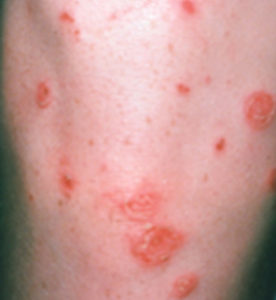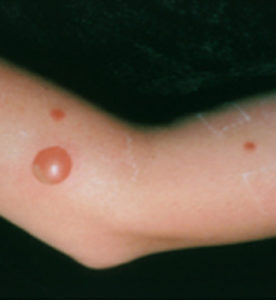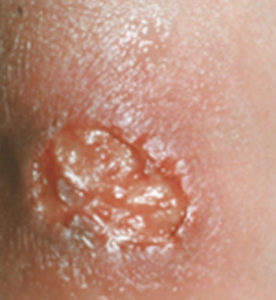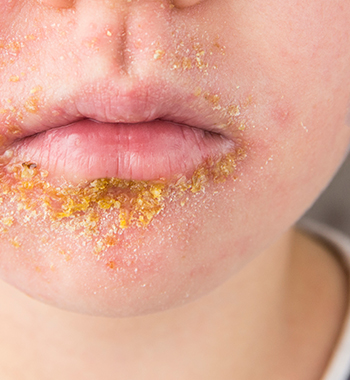What you see and feel differs with the type of impetigo. There are 2 types.

Impetigo on 5-year-old girl’s leg: The sore has broken open, so you see redness and honey-colored crusts.
Non-bullous impetigo is the most common type and goes through these stages:
- Starts with one or more sores, which are often itchy.
- The sores quickly burst, and the skin can be red or raw where the sores have broken open.
- Glands near the sores may feel swollen.
- Crusts, usually honey-colored, form.
- The skin heals without scarring, unless scratching cuts deep into the skin.
The infection can spread to other areas of the body, where you’ll see this process begin all over again. This is one reason treatment is so important.
Bullous impetigo causes fluid-filled blisters, but without redness on the surrounding skin; it progresses as follows:
- Blisters appear that contain a cloudy or yellow fluid.
- The blisters become limp and transparent and then break open.
- Crusty sores form where the blisters have broken open.
- The skin tends to heal without scarring.

Bullous impetigo on 12-year-old girl’s arm: This type causes painless, fluid-filled blisters. Bullous impetigo on boy’s knee: The blisters have ruptured, leaving crusty sores.

Ecthyma (ec-thy-ma) can develop when impetigo goes untreated. This is a more serious type of infection because it goes deeper into the skin and causes:
- Painful blisters
- Blisters turn into deep, open sores
- Thick crusts develop, often with redness on the surrounding skin

This began as a pus-filled blister on top of an insect bite and turned into the open sore you see here. Because the infection goes deeper into the skin, you may see scars once the skin heals.
If you notice any of these signs on your child’s skin (or your own skin), you should see your dermatologist, pediatrician, or family doctor. All types of impetigo are very contagious.
Treatment can help clear the infection and prevent the infection from spreading to others.
Kids often have skin-to-skin contact: Impetigo is very contagious and spreads with close contact.
Children aged 2 to 5 years old are most likely to get this extremely contagious skin infection. Anyone, however, can get impetigo. Older children and adults get it. Adults often catch impetigo from an infected child.
Some athletes have a higher risk of catching it. Because of the skin-to-skin contact in sports like wrestling and football, these athletes often get impetigo. The bacteria that cause impetigo thrive in warm, humid places, so swimmers also have an increased risk.
People who live in hot, humid areas get more cases of impetigo. In the United States, people often catch it in the summer or fall.
What causes impetigo?
Bacteria cause this highly contagious skin infection.
Most people develop it when the bacteria, usually staph or strep, invade injured skin. A scrape on your skin is often enough to get infected. The bacteria may also get in through a cut, insect bite, or anything else that damages the skin. Once inside, the bacteria cause an infection in the top layers of the skin.
Sometimes, the bacteria invade uninjured skin and cause impetigo.
How do dermatologists diagnose impetigo?
A dermatologist can often diagnose impetigo by looking at your skin.
Sometimes, lab tests are necessary to give you the diagnosis — or get information necessary to treat you. If you need a lab test, a dermatologist often takes a sample from a blister on your skin. This can tell your dermatologist which bacteria are causing the infection.
If your dermatologist thinks that the infection could be widespread, you may need a blood test.
How do dermatologists treat impetigo?
An antibiotic usually cures impetigo.
Dermatologists often prescribe an antibiotic that you apply to the skin, such as mupirocin (mew-peer-ah-cin) or retapamulin (reh-tah-pa-mu-lin). The U.S. Food and Drug Administration (FDA) has approved retapamulin to treat impetigo in children as young as 9 months old. Mupirocin is FDA approved to treat people 12 years of age and older.
When necessary, a dermatologist may prescribe one of these medicines to treat a child younger than the FDA-approved age. This is called off-label use and is legal. It can also be very helpful.
If a dermatologist prescribes an antibiotic you apply to the skin, you would apply it to the skin with impetigo. If you have several outbreaks of impetigo, you may need to apply it inside the nostrils. The bacteria that cause impetigo often thrive in the nostrils.
Sometimes stronger medicine is necessary. Your dermatologist can prescribe an antibiotic that you take by mouth. A few patients need injections of an antibiotic.
Skincare also plays an important role in clearing impetigo.
The following steps are often very helpful:
- Soak the skin with impetigo in warm water and soap to gently remove dirt and crusts.
- Apply the antibiotic (or other medicine) as prescribed.
- Cover the skin with impetigo to help it heal and prevent spreading the infection to others.
If a child gets impetigo frequently, your dermatologist may recommend adding a small amount of bleach to the child’s bath. This is completely safe when you follow the directions. A bleach bath can reduce the number of bacteria on the skin, which may prevent new infections.
Because impetigo is very contagious, a child may need to stay home from school for a few days. If this is necessary, your dermatologist will tell you when your child can return to school.
Teens and adults need not stay home, but they should take the following precautions to avoid infecting others:
- Avoid direct skin-to-skin contact with others.
- Keep blisters and sores covered with gauze bandages and tape.
- Wash their hands after touching or treating infected skin.
Your dermatologist can tell you how long to take these precautions.
Outcome for impetigo
Dermatologists recommend treating impetigo. It can help cure the impetigo and prevent others from getting this highly contagious skin infection.
With treatment, impetigo is usually no longer contagious within 24 to 48 hours.
Without treatment, impetigo often clears on its own in 2 to 4 weeks. During this time, there is a greater risk of developing complications. You may see new blisters and sores.
It’s also possible for the infection to go deeper into the skin if you don’t treat. If this happens, you can develop ecthyma (ec-thy-ma). This infection goes deeper into the skin than impetigo. As the skin heals from ecthyma, scars can form.
Ecthyma is more common in children, the elderly, and people who have diabetes. It also develops in the homeless and combat soldiers fighting in a hot and humid climate.
If you see anything on your skin that looks infected, it’s best to see a dermatologist as soon as possible. Early diagnosis and treatment can prevent complications and help you feel better.



